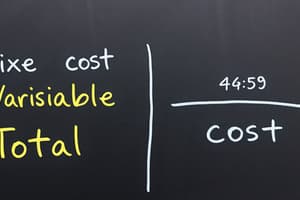Podcast
Questions and Answers
Which of the following best describes the difference between fixed and variable costs?
Which of the following best describes the difference between fixed and variable costs?
- Fixed costs remain consistent regardless of production, while variable costs fluctuate with production volume. (correct)
- Variable costs are constant, while fixed costs depend on production volume.
- Variable costs are the only costs incurred in production.
- Fixed costs change with production volume, while variable costs are constant.
How is the Old Value calculated when given a new value and a percentage change?
How is the Old Value calculated when given a new value and a percentage change?
- Old Value = New Value / (Percentage Change + 1) (correct)
- Old Value = New Value + (Percentage Change × New Value)
- Old Value = New Value - (New Value × Percentage Change)
- Old Value = New Value × (1 + Percentage Change)
What does the Contribution Margin (CM) represent?
What does the Contribution Margin (CM) represent?
- The difference between fixed costs and variable costs.
- The amount remaining after variable costs are deducted from sales revenue. (correct)
- The total sales revenue of a firm.
- The profit earned after all costs, including variable and fixed costs, have been taken into account.
Which formula accurately calculates Market Share?
Which formula accurately calculates Market Share?
How is Gross Profit defined?
How is Gross Profit defined?
What does the Herfindahl Index measure in terms of market analysis?
What does the Herfindahl Index measure in terms of market analysis?
What does the formula CM(%) = Contribution Margin($) / Price × 100% signify?
What does the formula CM(%) = Contribution Margin($) / Price × 100% signify?
In the context of marketing metrics, what are capital costs?
In the context of marketing metrics, what are capital costs?
To find the New Value based on an Old Value and a Percentage Change, which formula is applied?
To find the New Value based on an Old Value and a Percentage Change, which formula is applied?
Flashcards are hidden until you start studying
Study Notes
Fixed and Variable Costs
- Variable cost changes based on the production volume.
- Fixed cost remains constant regardless of the production volume.
- Capital cost has benefits lasting for more than a year.
- Operating cost has benefits lasting for a year or less.
Percentage Change
- The percentage change can be calculated with the formula:
Percentage Change (%) = ((New Value - Old Value) / Old Value) × 100% - The old value can be calculated with the formula:
Old Value = New Value / (1 + Percentage Change%) - The new value can be calculated with the formula:
New Value = Old Value * (Percentage Change (%) + 1)
Market Share and Market Analysis
- Market Share represents the firm's sales as a percentage of total market sales.
- Relative market share compares the firm's sales to the largest competitor's sales.
- Top Three or Four Firm Concentration Ratio measures the combined market share of the top three or four firms.
- Herfindahl Index is the sum of the squared market shares of each product or company.
Contribution Margin
- Contribution Margin ($) = Price per unit - Variable Costs per unit
- Contribution Margin ($) is the amount of money a product contributes toward covering fixed costs and generating profit.
- Contribution Margin (%) = (Contribution Margin($) / Price) × 100%
- Contribution Margin (%) represents the percentage of each sales dollar that contributes to covering fixed costs after covering variable costs.
- Variable Costs = Price × (1 - CM%)
- Price = Variable Costs / (1 - CM(%))
- Gross Profit = Total Revenue - Total Variable Costs
- Net Profit = Gross Profit - Fixed Costs
Marketing Value
- Customer perceived value = Benefits received - Costs incurred
- Benefits received include everything the customer receives from purchasing the product.
- Costs incurred include the price and any other non-financial costs such as time, effort, or inconvenience.
Studying That Suits You
Use AI to generate personalized quizzes and flashcards to suit your learning preferences.




